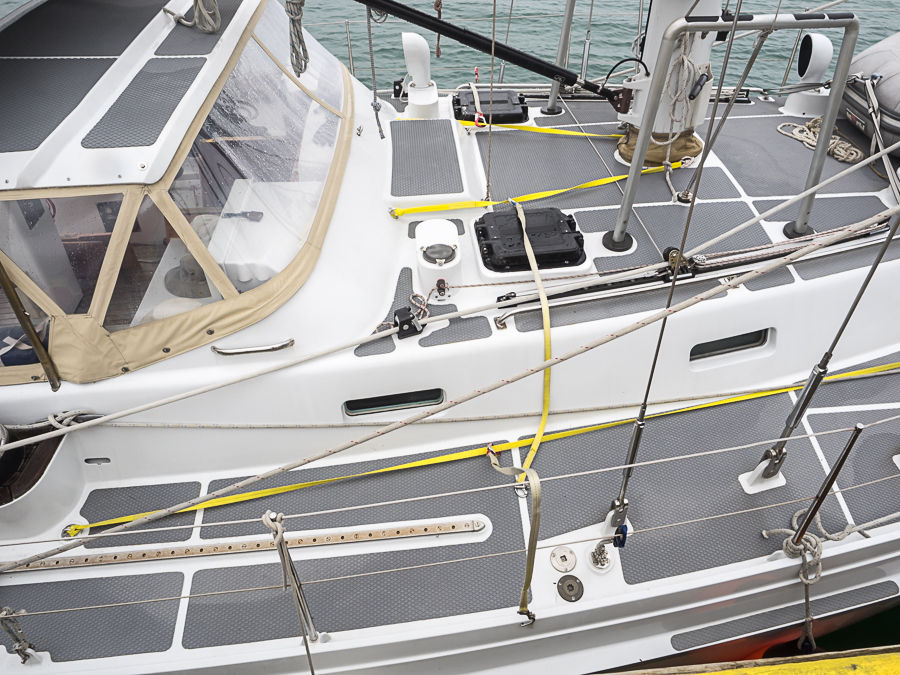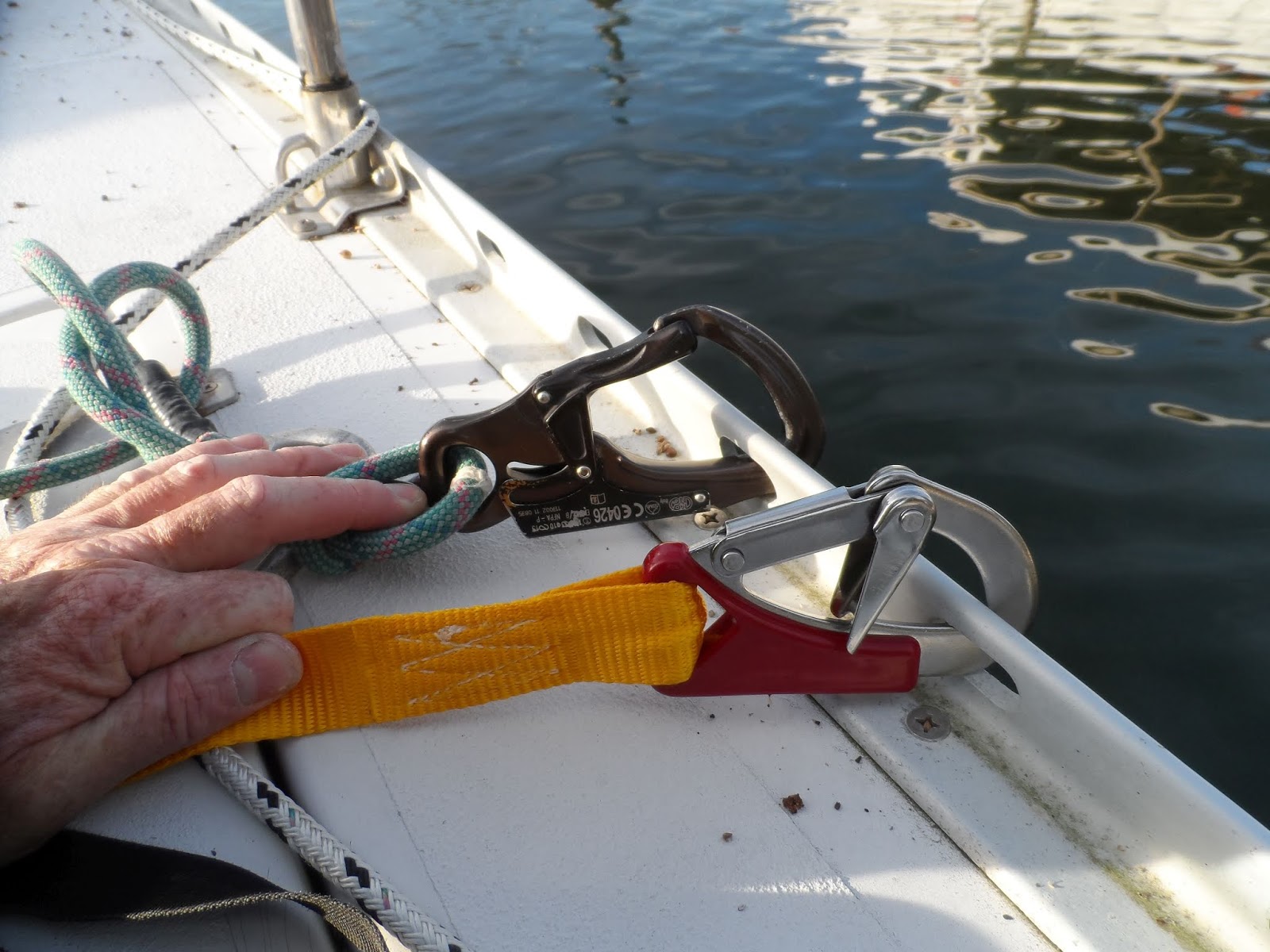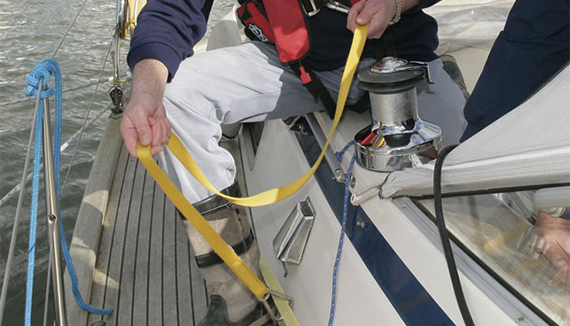Using Jacklines and Tethers
August 6th, 2020 by team

by B.J. Porter (Contributing Editor)
Jacklines and tethers can save your life. But used incorrectly, they won’t work and can even cause harm.
So what’s the proper way to use jacklines and tethers?
Jacklines need to be installed with enough tension in a position that won’t let you go overboard, and a tether should always attach to the boat or jackline.
There are more specifics about when to use them and how. But jacklines that let you overboard can kill you, and a tether that’s not attached to the boat is useless.
Jackline Installation

The risk of an improper jackline installation is that it will still let a sailor go overboard who may drag with the boat and drown. Jacklines give safety by helping you stay in the boat, but a jackline which will let you get dragged is dangerous, because it makes you feel safe but isn’t.
Jacklines need to be tight and installed so they don’t run all the way to the bow or stern if you can do it. Preferably, they should be as inboard as possible. While you need to reach the bow or stern with your tether on the jackline, running the jackline to the edge of the boat allows enough room for you to go overboard.
Most commercially made jacklines are flat webbing, which is recommended because it won’t roll under your feet like a round rope. Better quality jacklines like the ones we use are reflective, so they are visible at night if you’re carrying a light. Nylon webbing stretches when wet, so strap it tight when you install it.
Check the tension to see how much you can deflect the jackline from it’s installed line. You want as little wiggle room as possible. When you’re installing, clip a tether on it and haul it towards the lifelines. Does the end reach over the lifelines? Because if that end is clipped to your harness, that’s your body going over the lifelines if you fall.
If you are planning an overnight sail or are expecting heavy weather, install them before you leave. Installing jacklines in the dark or building weather is a lot more difficult.
Tether Choice and Use

Always use a double tether with an easy release clip. If you struggle to open the clip when it’s warm in the cockpit, it will be almost impossible fumbling in the dark with cold, wet hands, or in the water under load.
Our preference is for asymmetrical tether legs – a longer leg and a shorter one. For working, I prefer clipping with the shorter leg since it lowers the chance of going overboard if the jackline stretches. For moving I’ll use both, and when I’ve gotten where I’m going I’ll double clip on.
Higher quality tethers will have an indicator thread stitched into the webbing to show if the tether has ever overloaded; this is a World Sailing safety requirement. A shock-loaded tether will lose working strength, and the telltale thread will break when this happens. Replace any tethers with broken threads.
Moving Around the Boat with Jacklines and a Tether

“One hand for you, one for the boat” is only the beginning for safely moving on deck offshore, especially at night. If you are leaving the cockpit, always have one end of your tether attached to the boat.
Our rule offshore is anyone how comes above after dock tethers to something, even in the cockpit (where we have several handy rings). A few other excellent rules are:
- Never leave the cockpit without clipping on first. Jacklines should be installed so you can do this.
- Move slowly and carefully, so you can watch your footwork and what you’re clipping on to.
- When moving, always clip your next tether leg on before removing the last one.
- Always move on the high side of the boat, unless you have to work on the leeward side. Staying windward and clipping to the jackline on that side means if you fall, you’ll end up on the boat and not in the water.
- Double clip when you aren’t moving. Leave one end of your tether on the jackline, but you can loop the other end around a shroud, cleat, or other hard point on the boat as a backup.
- Do NOT clip to the lifelines. They aren’t usually strong enough to hold the point shock-load of your body on a tether. If you have to clip near a rail, go around a stanchion.
Additional Resources
Safety is a critical topic, and we hope you’ll look at a few more valuable resources to help you get your jacklines straight.
- Posted in Blog, Boat Care, Boating Tips, Cruising, Fishing, iNavX, Navigation, Reviews, Sailing, Sailing Tips
- No Comments


Leave a Reply